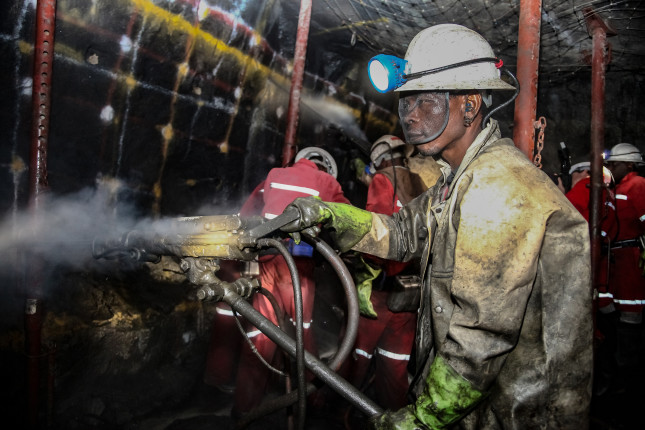-
The “Fuel of the Future” and Water Insecurity in South Africa’s Platinum Belt
May 16, 2022 By Tokollo MatsabuHydrogen fuel is becoming a central pillar of global decarbonization strategies. The hype over green hydrogen (the “fuel of the future”) and its potential to provide an abundance of low carbon fuel to transportation and industry has enticed several major emitting countries to scale up its production. And a UN-backed initiative wants to achieve a 50-fold production increase in the next six years.
How will it happen? Mining for platinum group metals (PGMs), which are critical to unlocking green hydrogen’s potential. These metals are used as a catalyst in electrolyzers that use renewable energy to split water. Current platinum production only supports 3 gigawatts (GW) to 7 GW of manufacturing capacity. But present ambitions call for PGM production that will need to satisfy demands for 100 GW by 2030.
The world is looking to South Africa to supply this surge. An estimated 84 percent of the world’s PGM reserves lay beneath a water scarce region in South Africa—the nation’s “platinum belt.” Yet the scarcity of water in the belt matters. Mining platinum is an extremely water intensive activity which heavily pollutes precious water resources. And a 2020 study on green energy minerals, platinum came out on top as the metal with the highest ESG Risk.
South Africa is already a water-scarce country. As recently as 2018, Cape Town was on the brink of becoming the first major city in the world to run out of water. South Africa’s government estimates that demand will outstrip supply as early as 2025.
Can South Africa balance the extraction of these metals and the environmental, economic, and social costs of doing so?
South Africa’s green hydrogen fuel ambitions
South Africa is positioning itself as a green hydrogen hub. In partnership with several entities, its government plans to build out a “hydrogen valley.”
This zone of operations will start in Mokopane, Limpopo, where mining communities are already fighting a legal battle against the mining company Anglo American Platinum for resettlement compensation and water provision. The corridor will extend to Joburg’s industrial and commercial center, before ending up in Durban on South Africa’s east coast. The hub is centered around the enterprise of British miner Anglo American Platinum, the world’s largest platinum producer. The United Kingdom has an extensive history of exploiting and profiting off South Africa’s mineral wealth at the expense of local populations.
Environmental justice and water security for frontline platinum communities will be harder to secure as government and business interests align in the race for green hydrogen. Platinum belt communities are at risk of becoming green sacrifice zones to satisfy the climate ambitions of Global North countries (fixing a problem they largely caused in the first place).
Water scarcity—in South Africa and elsewhere—is a key concern. Green hydrogen production itself requires large amounts of freshwater resources too. Close to 85 percent of current projects in the pipeline for 2040 are due to be built in water-stressed regions around the world. Most of these projects will need to rely on desalination, driving up the true investment costs of production. Investments in green hydrogen will need to account for costs related to the desalination of water resources at mine sites and hydrogen production sites, while accounting for the costs of implementing better wastewater management practices and re-using treated acid mine drainage.
Given the urgency of scaling up green hydrogen, a rapid rise in platinum demand will see water security issues intensify for platinum belt communities. Acid mine drainage decimates local water resources threatening the water security and health of frontline mining communities and workers. Chemicals leaking into local water resources results in health implications for local populations, and a loss of livelihood as poisoned water kills livestock and can’t be used for agriculture (in addition to the soil erosion from mining activity). The green hydrogen supply chain, investors, and mining companies must internalize the costs associated with technologies that restore water to drinking standard (e.g., through reverse osmosis, ion exchange, or activated carbon absorption).
Climate, Communities, and Conflict
South Africa’s platinum belt is no stranger to water restrictions to deal with drought, inevitably affecting mining production. Environmental activists have been killed opposing industrial mining that threatens water supplies. Citizens have been killed protesting over water shortages. Climate change and prolonged drought will only increase conflict over water use where restrictions on mining operations will become more frequent.
A recent report by Amnesty International, the Centre for Applied Legal Studies, and the Sekhukhune Combined Mining-Affected Communities tells the familiar story of communities in Limpopo Province suffering multiple health and socioeconomic issues stemming from platinum mining activity. On the consortium’s visits to three mining sites, it discovered the ways in which platinum mining companies (including Anglo American Platinum) are shirking their responsibilities to provide surrounding communities with water and sanitation, and clean-up.
Among the serious issues discovered include unfinished water and sanitation projects at schools, partially completed water supply projects, and non-compliance with requirements to submit annual reports and track progress. South Africa also has neglected its oversight duties. For instance, when the government tried to make platinum mining companies pay $49 million to compensate for water costs, a lack of systemic state capacity to enforce compliance meant that some platinum operations simply ignored the directive.
South Africa has laws in place to improve environmental and social governance in mining. Local legislation obliges companies to create comprehensive community development plans, including provisions for water conservation and infrastructure. Companies are supposed to report on their progress annually, yet Amnesty, CALS and Sekhukhune found that the Department of Mineral Resources has failed to enforce compliance.
Conflict between communities and companies will only increase as drought spurred by climate and mining gets worse. Socioeconomically vulnerable community populations will continue to be at heightened risk of food and water shortages to extract a steady supply of hydrogen fuel, a commodity that they may never use themselves (e.g., in cars and planes).
Losses of livelihood from contaminated water and soil also mean that platinum belt communities are fertile ground for civil unrest. Given the concentration of platinum resources in the region, not addressing inherent ESG and water issues with platinum mining could create supply chain bottle necks with international ripple effects.
International Interventions
A lack of state capacity to enforce compliance is common among resource-rich Global South nations. Yet it’s clear that international human rights treaties are paper tigers in the face of economic interests. And the wellbeing of local communities in South Africa’s platinum belt and elsewhere who have contributed least to the climate change problem will be sacrificed in pursuing solutions to the crisis.
Platinum mining for green hydrogen electrolyzers is a global problem, where the end users are predominantly larger emitters who will reap the benefits of decarbonizing their societies. These beneficiaries of hydrogen consumption are inevitably nations of the Global North (and larger developing countries, e.g. China) who have benefitted from the systemic exploitation of Africa’s resources. The race for green technology minerals risks perpetuating the same colonial dynamics, but with a greener face. At a minimum these countries can implement key environmental and water conservation requirements on the processed material, or the finished product of hydrogen fuel.
What can the beneficiaries do to right the scales? The international community should consider a global and legally-binding treaty on critical minerals, where demand-side countries agree to limit the import and trade of platinum—as well as hydrogen fuel that doesn’t meet certain water security standards. These standards would include requirements on water treatment plants at mine and hydrogen production sites and providing fresh-water resources for surrounding communities.
The Hydrogen Council suggests developing Hydrogen certification schemes as a policy tool to measure environmental sustainability of sourced fuels across the value chain. Nations should seize the opportunity to include explicit language on requirements pertaining to water health and security of mineral resources used in hydrogen production. This could also have a cascading effect on improving the ESG conditions of other critical minerals in green hydrogen production such as copper, nickel, and aluminium.
The European Union and countries including the United Kingdom, Canada, Japan, and Australia can exert top-down pressure to mitigate against water insecurity and harm. As the largest markets who will consume green hydrogen the most, creating a gateway in the international market for hydrogen fuel that applies robust environmental security standards will compel upstream players (including mining companies) to improve their ESG impact. If upstream players and mining companies cannot meet these environmental security standards, their products cannot access the biggest markets. These new standards could cascade into markets for other critical minerals involved in the production process including copper, nickel, aluminium.
Currently, there are ESG regulations in development that can be applied to platinum (and critical minerals at large). As a leading market for green hydrogen fuel demand, the EU could expand its existing Conflict Minerals regulations to include environmental human security risks thereby expanding the number of minerals subject to import restrictions. The EU commission also is currently debating on implementing an import ban on products that have contributed to deforestation. It could consider applying a similar restriction on platinum that has contributed to water security issues. Another regulation currently under proposal is requiring companies to identify and mitigate against human rights and environmental violations along their entire supply chains. This has the ability to put further pressure on upstream players as large companies are major customers.
Other nations should also examine what levers are at their disposal. The Canadian province of Alberta is developing lifecycle regulation of mineral extraction for technologies (e.g., CCS) that could include clauses with water security requirements. The United States could include water security requirements in its federal procurement processes for its own national hydrogen hub. Investment flows to hydrogen should also consider scaling R&D funding to find non-platinum catalysts that could diversify platinum supply and reduce overall demand.
The right to clean water and sanitation is a universal human right. With increasing scrutiny on the ESG performance and human rights conduct of mining companies, water security can be embedded in key regulations and policies governing supply chain resiliency.
Tokollo Matsubu is an ESG Analyst at the Environmental Defense Fund
Sources: Hydrogen Council; Nature; Journal of the Southern African Institute of Mining and Metallurgy; Deutsche Welle; Mineral Economics; News 24; WorldWater.org; Amnesty International; Mining Review; IEA; Cito Energy Group; Argonne National Laboratory
Image Credit: Chrome and Platinum miners drill holes to place dynamite in a mine in northeastern South Africa. Courtesy of Sunshine Seeds, Shutterstock.com.
 A Publication of the Stimson Center.
A Publication of the Stimson Center.







